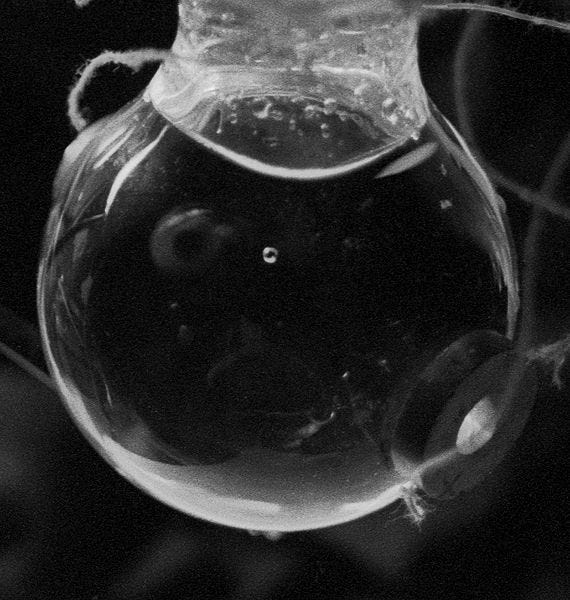The Enigmatic Nature of Sonoluminescence: Unraveling Its Secrets
Written on
Chapter 1: The Fascinating World of Sonoluminescence
Sonoluminescence presents a mesmerizing scientific mystery, where sound waves generate brief flashes of light in a liquid medium. Central to this occurrence is the formation, rapid growth, and eventual collapse of gas-filled bubbles within the liquid, often containing noble gases such as helium or argon. Upon their collapse, these bubbles emit a short-lived yet brilliant burst of light. While the exact mechanisms that facilitate sonoluminescence are not fully understood, various theories have been proposed to shed light on this captivating phenomenon.

Theoretical Explanations and Insights
Several theories attempt to explain the mechanisms behind sonoluminescence:
- Bremsstrahlung Radiation: One hypothesis suggests that Bremsstrahlung radiation, which results from the acceleration of charged particles like electrons, may be responsible for sonoluminescence. As the bubble collapses, the internal gas undergoes significant compression, leading to a rapid increase in temperature and pressure. This compression accelerates electrons, causing them to emit radiation, which appears as the luminous flash.
- Adiabatic Heating: Another theory posits that adiabatic heating drives the phenomenon. This occurs when a gas is rapidly compressed, resulting in a temperature spike. The quick compression of gas within the imploding bubble could generate sufficient heat to produce light.
- Plasma Formation: Some researchers propose that the extreme conditions within the collapsing bubble may create plasma—an ionized state of matter composed of charged particles. The light emitted during the recombination of these particles could explain the flashes observed in sonoluminescence.
- Quantum Vacuum Radiation: A more speculative notion suggests that the interaction between the collapsing bubble and the quantum vacuum—the lowest energy state of a quantum field—could lead to sonoluminescence. The rapid collapse might create a strong local disturbance in the vacuum, converting virtual particles into real ones that emit light as they annihilate.
Despite these intriguing theories, the true mechanism behind sonoluminescence continues to elude scientists. Ongoing research aims to decipher this complex phenomenon, and it is possible that a combination of these theories—or even a yet-to-be-discovered mechanism—may explain the light emissions associated with sonoluminescence.
The first video titled Mysterious Natural Phenomena Scientists Are Still Trying to Understand delves into various unexplained natural occurrences, including sonoluminescence, providing insights into the ongoing research and theories surrounding these enigmatic phenomena.
Challenges in Understanding Sonoluminescence
Our current inability to fully grasp sonoluminescence can be attributed to its inherent complexity and the numerous challenges presented by experimental conditions. The extreme circumstances during bubble collapse—reaching temperatures of tens of thousands of degrees Kelvin and pressures of several hundred atmospheres—make it challenging to replicate and study the phenomenon in controlled environments.

This phenomenon occurs within an incredibly brief timeframe, with light emissions lasting only picoseconds (10^-12 seconds). Such fleeting durations complicate traditional experimental approaches. Additionally, the small size of the collapsing bubbles—typically just a few micrometers in diameter—further complicates observational studies, necessitating specialized equipment and techniques.
Moreover, the intricate interplay of various processes involved in sonoluminescence, such as fluid dynamics, acoustics, heat transfer, radiation, and plasma physics, adds to the complexity. The lack of a comprehensive theoretical model that unifies all experimental observations suggests that a synthesis of existing theories, or perhaps an undiscovered mechanism, may underpin this phenomenon.
Continued Research and Future Perspectives
Despite these substantial hurdles, researchers remain dedicated to uncovering the mysteries of sonoluminescence, striving to deepen our understanding of the underlying processes and mechanisms. As experimental techniques and theoretical frameworks evolve, there is hope that a clearer comprehension of sonoluminescence will eventually emerge.
In the second video titled The Proof Is Out There: WILD Theories for Mysterious Natural Phenomenon, various theories—including those related to sonoluminescence—are explored, highlighting the diverse approaches scientists take to understand these extraordinary natural events.
Thank you for reading! If you enjoyed this exploration, feel free to show your appreciation by clicking the clap icon as many times as you like. To support my work, consider becoming a Medium member through this link, or perhaps buy me a coffee. Stay tuned for more fascinating stories!